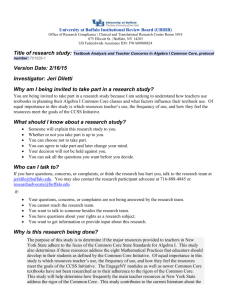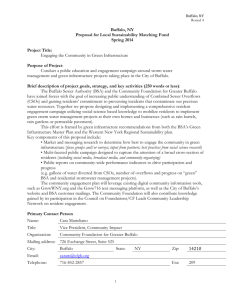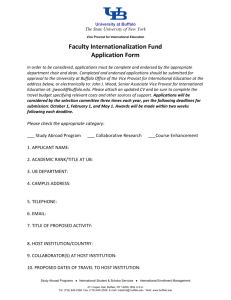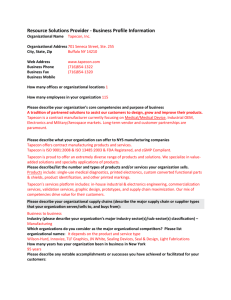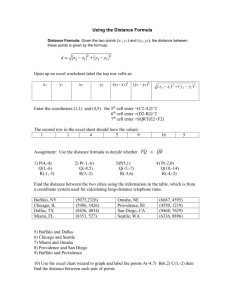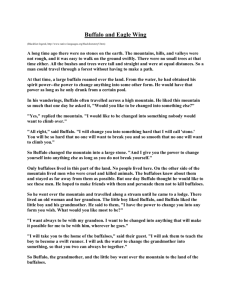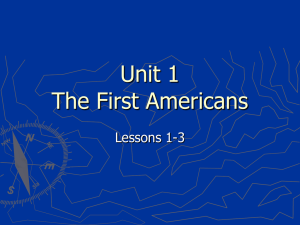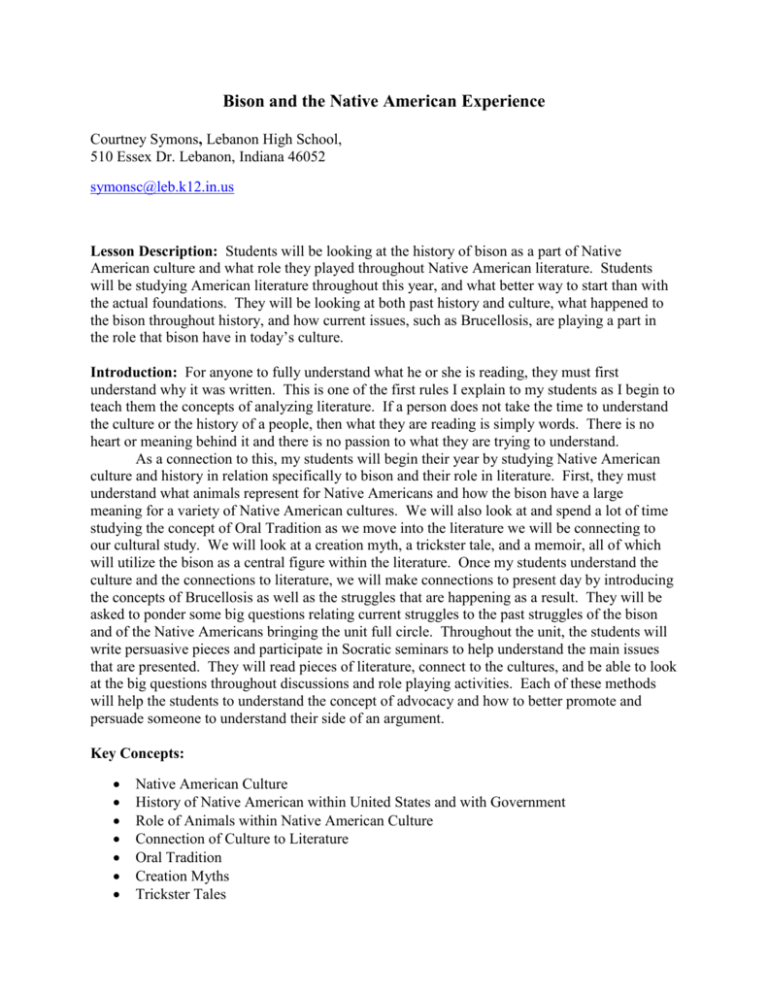
Bison and the Native American Experience
Courtney Symons, Lebanon High School,
510 Essex Dr. Lebanon, Indiana 46052
symonsc@leb.k12.in.us
Lesson Description: Students will be looking at the history of bison as a part of Native
American culture and what role they played throughout Native American literature. Students
will be studying American literature throughout this year, and what better way to start than with
the actual foundations. They will be looking at both past history and culture, what happened to
the bison throughout history, and how current issues, such as Brucellosis, are playing a part in
the role that bison have in today’s culture.
Introduction: For anyone to fully understand what he or she is reading, they must first
understand why it was written. This is one of the first rules I explain to my students as I begin to
teach them the concepts of analyzing literature. If a person does not take the time to understand
the culture or the history of a people, then what they are reading is simply words. There is no
heart or meaning behind it and there is no passion to what they are trying to understand.
As a connection to this, my students will begin their year by studying Native American
culture and history in relation specifically to bison and their role in literature. First, they must
understand what animals represent for Native Americans and how the bison have a large
meaning for a variety of Native American cultures. We will also look at and spend a lot of time
studying the concept of Oral Tradition as we move into the literature we will be connecting to
our cultural study. We will look at a creation myth, a trickster tale, and a memoir, all of which
will utilize the bison as a central figure within the literature. Once my students understand the
culture and the connections to literature, we will make connections to present day by introducing
the concepts of Brucellosis as well as the struggles that are happening as a result. They will be
asked to ponder some big questions relating current struggles to the past struggles of the bison
and of the Native Americans bringing the unit full circle. Throughout the unit, the students will
write persuasive pieces and participate in Socratic seminars to help understand the main issues
that are presented. They will read pieces of literature, connect to the cultures, and be able to look
at the big questions throughout discussions and role playing activities. Each of these methods
will help the students to understand the concept of advocacy and how to better promote and
persuade someone to understand their side of an argument.
Key Concepts:
Native American Culture
History of Native American within United States and with Government
Role of Animals within Native American Culture
Connection of Culture to Literature
Oral Tradition
Creation Myths
Trickster Tales
Memoirs
Current Issues with Bison
Connection of Current Issues to Historic Issues
Advocacy and Persuasion
Objectives:
Students will be able to recognize and understand the cultural significance of the bison
and other animals to the Native American Culture.
Students will be able to understand the history of the Native American.
Students will be able to connect history and culture of the Native Americans to the
literature that they read.
Students will be able to recognize different styles of literature important to Native
American Culture (specifically oral tradition, creation myths, trickster tales, and
memoirs) and will be able to illustrate the characteristics of each.
Students will be able to illustrate through writing their understanding of the issues.
Students will be able to illustrate their ability to choose a side of an argument and
persuade others through facts and connections to understand and consent with their side.
Content Standards:
English/Language Arts 11.1.1-3, 11.2.1-3, 11.3.1-8, 11.4.1-4, 11.6.1-4, 11.7.1, 11.7.2, 11.7.4,
11.7.6, 11.7.7, 11.7.8, 11.7.16, 11.7.17, 11.7.18
Resources and Materials:
Textbook
Handout of Creation Myth “Buffalo Woman”
Handout of Creation Myth “Buffalo and Eagle Wing”
“The Way to Rainy Mountain”
http://nexuslearning.net/books/Elements_of_Lit_Course5/Way_Rainy.htm
“They Coyote and the Buffalo”
http://www.mc.maricopa.edu/~tomshoemaker/mourningdove/coyote05.html
Various Worksheets and assignment handouts
News article on Iroquois Lacrosse Team
http://abcnews.go.com/Sports/wireStory?id=11161810
Powerpoint – American Bison: Then and Now, by Curts, Shover, & Symons
http://www.indstate.edu/publiclanduse/Instructional%20Powerpoints.htm
Slideshow – Relevant photos from Yellowstone National Park are available at:
http://www.indstate.edu/publiclanduse/photos.htm
Computer
Projector
Time Required: This plan is for a comprehensive unit plan developing over a span of eleven
class periods. The class periods are eighty-two minutes long and meet on alternating days. This
plan culminates in a final project which will be due a week after the end of the unit.
Procedures:
Day 1 –
1. Brain dump in partners of all the stories they know with animals as characters.
2. Background information of animals and their meaning in Native American culture –
Handouts on Totem animals (Native American Legends) and Animal Symbolism
3. Worksheet on animals and influence in stories – do first two columns and revisit
examples in literature after reading stories.
4. Importance of bison to Native Americans.
HW: (on handout) #1 – Based on their characteristics discussed in class (or individual
research) what is your totem animal and why? #2 – Why do you think the bison are so
important to Native American Culture?
Day 2 –
Discuss Bison in literature – pictures, history, and examples.
Importance of bison – show first part of slideshow through buffalo in literature slide.
Discuss Oral Tradition
Small group activity – discuss Why bison?
Transition to Creation myths.
a. Different nations.
b. Different traditions.
c. This is their religious beginning.
6. Notes on different types of Creation Myths and characteristics.
7. Begin reading creation myth
HW: Read “Buffalo Woman” and “Buffalo and Eagle Wing.” Answer comprehension
questions.
1.
2.
3.
4.
5.
Day 3 –
1. Discuss story and big questions – what is the role of Buffalo in the story.
2. Creation Myth Worksheet – which type of creation myth is this? What characteristics
does this include?
3. Creation Myth Writing prompt – Why are stories like this creation myth so difficult for
modern generations to understand? Begin brainstorming and pre-writing in class.
Discuss ideas together.
HW: Finish writing prompt as homework.
Day 4 –
1.
2.
3.
4.
5.
Think-Pair-Share- Discuss writing prompt from night before.
Wrap-up creation myth lesson.
Transition into trickster tales (share Journal from beginning of class).
Background of Trickster tale and archetypal Trickster character.
Activity – Modern day tricksters – based on characteristics of tricksters, TPS the ultimate
trickster character and trickster tale.
6. Exit slip – What role do you expect the buffalo to play in “The Coyote and the Buffalo”?
HW: Read “The Coyote and the Buffalo;” do comprehension questions
Day 5 –
1. Writing quiz – compare/contrast the role you expected the buffalo to play with the role he
actually played in the story. Does this fit with the role of buffalo in Native American
culture? Why?
2. Discuss story – timeline out on board – class activity
3. Handout long-term writing assignment – compare the role of Buffalo in these two pieces.
What does it say about the values of the Native American Culture? What are the
similarities and differences and what do you think these show?
4. Brainstorm writing prompt ideas as a class – assignment due in 2 classes.
HW: Work on paper. Read background information in book.
Day 6 –
1. Background information of Native Americans and struggles with US Government.
a. Tensions
b. Bison issue and bison killed.
c. Reservations.
d. Motivations
2. Finish Powerpoint presentation.
HW: Paper due next class.
Day 7 –
1. Group activity – Students will be divided into groups (tribes). Each tribe member will be
given a role within the group. There will be a chief, warriors, and regular tribes
members. They will be given a specific area of the classroom and a quantity of
“property” that they must protect from the encroaching and invading American
government. They must decide, as a tribe, what they will do when faced with the
situation of their livelihoods being at risk. Do they fight for everything or try to make a
deal with the government. The teacher will play the role of government. Students will
then come together as a class and discuss with everyone their decisions and how each
tribe reacts to said decisions.
2. Writing wrap-up: What did you think of this activity? What did you think of your rival
tribes’ decisions?
HW: Read article on the Iroquois Nation not being allowed to enter England and do
corresponding handout. Should they be required to obtain American or Canadian
passports? Can they be kept out? Be prepared to discuss in class next period.
Day 8 –
1. Journal – after pondering yesterday, how do you feel about it now?
2. Socratic seminar – Should the Iroquois be kept out of England and required different
passports? Why or why not?
3. Check understanding of Native American background information.
4. Introduce concept of memoir – what is it? Why is it an important style of writing?
5. TPS other popular memoirs.
6. N. Scot Momoday Background information.
HW: Read “The Way to Rainy Mountain.” Comprehension questions
Day 9 –
1.
2.
3.
4.
Slideshow on my “Rainy Mountain.”
Heritage and tradition activity.
Discuss “Rainy Mountain.”
Small group worksheet over “The Way to Rainy Mountain.”
HW: Write 3 paragraphs on connecting the story and the background information.
Include 3 examples
Day 10 –
1. Bison now – Brucellosis
2. Powerpoint presentation
3. Big Question – Is what is happening now, killing and slaughtering of bison for economic
benefits of others, similar to what happened originally between the Native Americans and
the American government?
HW: Write two paragraph comparing current issues with past issues.
Day 11 –
1. Quiz
2. Socratic Seminar over big question from previous class period.
3. Introduce final project – Bridging the gap.
Final Assessment: For the final assessment, students will produce a project based on the concept
of bridging the gap between their heritage and Native American heritage. Students will be asked
to investigate their own heritage and traditions. They will then be required connect these
findings to the Native American traditions and culture that we have studied both through a
writing project and through a visual presentation.
Extension:
Each class period is an extension of the previous class period.
The final assessment is an extension of the unit itself.
As the students progress throughout the semester, they will discover that all Early American
Literature has foundations in Native American and will therefore connect.
Interdisciplinary connections:
Social studies connections with Native American background and history.
Environmental science connections with current and past bison issues.
NATIVE AMERICAN LEGENDS
Native American Totems & Their Meanings
A totem can be the symbol of a tribe, clan, family or individual.
Native American tradition provides that each individual is
connected with nine different animals that will accompany each
person through life, acting as guides. Different animal guides
come in and out of our lives depending on the direction that we
are headed and the tasks that need to be completed along our
journey.
Native beliefs further explain that a totem animal is one that is
with you for life, both in the physical and spiritual world. Though
people may identify with different animal guides throughout their
lifetimes, it is this one totem animal that acts as the main
guardian spirit.
With this one animal a connection is shared, either through
interest in the animal, characteristics, dreams, or other
interaction.
This Animal Guide offers power and wisdom to the individual
when they "communicate” with it, conveying their respect and
trust. This does not necessarily mean that you actually pet or
spend time with this animal, more that you are open to learning
its lessons.
Totem Pole at Pioneer Square in Seattle,
Washington , vintage postcard.
For some, knowing what is their totem animal is almost an innate process. It’s as if
they’ve always known, inexplicably drawn to the animal or having a special feeling for
the animal’s energy. For others, they wonder how to tell what their animal totem is.
Here are some questions to ask yourself if you’re wondering what your animal totem is:
Have you ever felt drawn to one animal or another without being able to explain
why? This could be animal, including birds and insects.
Does a certain kind of animal consistently appear in your life? This doesn’t
necessarily have to be a physical appearance, it could be represented in other
ways such as receiving card and letters with the same animal pictured over and
over, unexplainable dreams of a particular animal, watching television and
seeing the same animal featured time and time again, or, actually having the
animal show up.
When you go to the zoo, a park, wildlife area, or forest, what are you most
interested in seeing?
Are there any animals that you find to be extremely frightening or intriguing?
Is there a particular animal that you see frequently when you’re out in nature?
Have you ever been bitten or attacked by an animal?
Have you ever had a recurring dream about a certain animal, or a dream from
childhood that you have never been able to forget?
Are you drawn to figurines or paintings of a specific animal?
The totem itself is a symbol that represents this animal. This could be any number of
items - a crest, a totem pole, an emblem, a small figurine or anything else that depicts
your animal guide.
Note: Native American totems did not include all of the animals listed below, as many of
these creatures did not existed in North America. However; the concept of "totems," by
whatever name they were called, have been known throughout the world since the
earliest days of Greek Mythology. Though the unicorn is generally accepted as a
centuries old mythical creature of Europeans, pictures of this fabled animal have been
found in Native American tapestries and pictographs
Animal Characteristics & Meaning
Alligator
Maternal, revenge oriented, quickness, aggression, and basic survival
instincts.
Ant
Group minded, determination, patient, active, and industrious
Anteater
Lethargy, curiosity, nosiness.
Antelope
Active, agile, jumpiness, and willing to sacrifice
Armadillo
Safety oriented, grounded, and has boundaries
Badger
Courage, aggressive, healer, having problems relating to others, and energy
conduit
Bat
Rebirth, longevity, secrecy, initiation, good listener, and long life
Bear
Industrious, instinctive, healing, power, sovereignty, guardian of the world,
watcher, courage, will power, self-preservation, introspection, and great
strength.
Beaver
Determined, strong-willed, builder, overseer, and protector
Bee
Organized, industrial, productive, wise, community, celebration, fertility,
defensiveness, obsessive nature, and enjoys life
Boar/Pig
A very powerful totem - prosperity, spiritual strength, organized, self-reliant,
fearless.
Buffalo
Sacredness, life, great strength, abundance, gratitude.
Bull
Insight into the past, fertility, rushing into things without proper preparation.
Butterfly
Metamorphosis, transformation, balnace, grace, ability to accept change
Camel
Survival, positive, accomplishments
Caribou
Traveler, mobility, preference to be nomadic, adaptability to adversity
Cat
Guardianship, detachment, sensuality, mystery, magic, and independence
Cheetah
Swiftness, insight, focus
Cougar
Leadership, loyalty, courage, taking responsibility, foresight
Cow
Swift, insightful, and focused
Coyote
Trickster, intelligence, stealth, wisdom and folley, guile and innocence
Cobra
Swift and decisive
Crab
Good luck, protection and success
Crane
Solitude, justice, longevity, independent, intelligent, and vigilant
Crocodile
Ensuring your emotions are displayed accurately/appropriately
Crow
Justice, shape shifting, change, creativity, spiritual strength, energy,
community sharing, and balance
Deer
Compassion, peace, intellectual, gentle, caring, kind, subtlety, gracefulness,
femininity, gentleness, innocence, and seller of adventure
Dog
Noble, faithful, loyal, teaching, protection, and guidance
Dolphin
Kind, salvation, wisdom, happiness, playfulness, prudent, capable of deep emotion, and happy.
Dove
Cross-world communication, spirit messenger, peace, gentleness, love
Dragon
Longevity, richness, prosperity, infinity, wisdom, power, and fiery
Dragonfly
Flighty and carefree, strong imagination, higher aspirations.
Duck
Water energy, helper of seers, can clearly see/deal with emotions
Eagle
Divine spirit, sacrifice, connection to creator, intelligence, renewal, courage, illumination
of spirit, healing, creation, freedom, and risk-taker
Elephant
Strength, power, affection, loyalty, royalty, and wisdom
Elk
Strength and agility, pride, majestic, independence, purification, strength, and nobility
Falcon
New beginnings, adventure, passionate, and leadership.
Fish
Graceful, slyness, open-minded, quick to change one's mind.
Flamingo
Heart healing, psychic, people person, flirtatious.
Fox
Cunning, agility, quick-witted, diplomacy, wildness, feminine magic of camouflage,
shapeshifting and invisibility
Frog
Water energy, cleansing, rebirth, sensitivity, medicine, hidden beauty, peace, adaptability,
poor character judgment and power.
Gazelle
Aggressive
Giraffe
Communication, intuition, attaining the unreachable, seeing the future
Goat
Surefootedness, stubbornness, independence, diligence, lack of foresight.
Goose
Self-demanding, reliable, prudent, rigid, vigilance, parenthood, and productive.
Gorilla
Family-oriented, intelligence, strength, environmental protector, keeps peace through aggression.
Grasshopper
Good luck, abundance, forward, progressive.
Grouse
Personal power, enlightenment.
Hawk
Messenger, intuition, victory, healing, nobility, recollection, cleansing,
visionary power, and guardianship.
Heron/Egret
Aggressive, self-determined, self-reliant, multi-tasking, balanced.
Hippopotamus
Power, creation, imagination, healing.
Horse
Freedom, stamina, mobility, the land, travel, power, and freedom.
Hummingbird
Messenger, timelessness, healing, and warrior.
Jaguar
Chaos, shape-shifter, aggressiveness, power.
Kangaroo
Forward, balance, creative, stamina.
Lion
Family, strength, energy, courage, guardian and protector.
Lizard
Conservation, vision, self-protection, hidden defenses.
Llama
Comforting to others, secure.
Lynx
Keeper of secrets, guardian, listener, and guide.
Mole
Sensitivity, guidance, searching.
Monkey
Ability to change the environment, health, success.
Moose
Headstrong, longevity, steadfastness, and wisdom.
Mouse
Scrutiny, order, organizer, and an eye for details.
Octopus
Intelligence, camouflage, nocturnal.
Opossum
Diversion, strategist, and deceiver.
Ostrich
Grounded, practical.
Otter
Playful, friendly, dynamic, joy, helpfulness, and sharing
Owl
Deception, clairvoyance, insight, messenger.
Ox
Sacrifice, chastity and self-denial
Panther
Protection, hidden emotions, introspection, caution, careful decisions
Parrot
Communication, beauty, guide for wisdom, mockery, thinking before speaking
Peacock
Immortality, dignity, and self-confidence
Pelican
Resilient, unselfish, rising above.
Penguin
Self-discipline, grace, self-confidence, spiritual
Porcupine
Innocence, companionship, and trust
Prairie Dog
Swiftness, industrious, constructive, preparedness
Puma
Companion on journeys to other worlds, grace, silent power
Quail
Group-work, team play, creator of harmony and group tolerance,
protectiveness (especially toward children)
Rabbit
Fear, timidity, nervousness, humility, rebirth,
Raccoon
Curiosity and cleanliness
Ram
Stoic, sensitive, persevering, curious, imaginative.
Rat
Fertility, stealth, scavenging, intelligence, enjoys luxury
Raven
Introspection, courage, self-knowledge, magic
Rhinoceros
Wisdom, solitary, insightful, solid.
Roadrunner
Mental agility, speed, opportunistic.
Rooster
Vanity, likes to be showered with gifts and attention, early riser,
settling for nothing less than the best
Salmon
Proud, intense, confident, wisdom, inspiration
Scorpion
Transforming, strong, inspiring, chaotic, passionate
Seagull
Versatility, loud, easy-going nature, creativity, laziness
Seahorse
Confidence and grace
Seal
Love, longing, dilemma, active imagination, creativity
Shark
Hunter, survival, and adaptability
Skunk
Reputation, presence, and strength
Snail
Protective, aware, solitary.
Snake
Impulsive, shrewdness, rebirth, transformation, initiation, and wisdom
Spider
Balance, wisdom, creativity, communication
Squirrel
Planner and gatherer
Stag
Lord of the forest, masculine power of regeneration, signs.
Swan
Grace, balance and innocence, soul, love, beauty, of the self
Tiger
Strength, valor, power, and energy
Toad
inner strength, luck, self-examination
Turkey
Generosity, life-giver, and sharer
Turtle
Nurturer, shy, and protecting
Unicorn
Purity, innocence, dreamer, personal power, gentle
Weasel
Strength, energy, ingenuity and stealth
Whale
Wisdom, provider, intelligence, and kindness.
Wolf
Loyalty, perseverance, success, intuition, and spirit
Woodpecker
Sensitive, protective, and devotion
Zebra
Agility and individuality
Native American Animals and Their Meanings
Buffalo – The Native American used every part of the Buffalo they hunted and
thus the buffalo became a symbol for abundance, prayer, and gratitude. When
you are attracted to buffalo you are being asked to renew your connection to
higher power through prayer and thankfulness for all you have. In doing so,
you will attract more into your life. Buffalo teaches that what you need will
always be provided.
Eagle – Eagle flies high, close to God. He focuse the big picture but with his
eyesight he can also perceive the most minute details. The eagle is the symbols
for spirit. If he is in your life, you are likely to be going through a time of great
spiritual growth, initiation, and change.
Bat – Transition, rebirth, understanding of grief, invisibility, transition.
Cow – The cow is a nurturing mother goddess who reminds you to be gentle
with yourself and to take better care of yourself. If she shows up around you,
slow down, take joy in simple pleasures, and pay attention to your needs.
Coyote- Almost universally the coyote is the trickster or the sacred clown. His
antics make us laugh and he reminds us not to take life so seriously. Sprit
influence includes understanding all things yet nothing is sacred, stealth, and
intelligence. If coyote comes in your life things may look all messed up for a
while until you discover that life is really working in your favor. Develop a
sense of humor and go with the flow.
Elk – Elk’s wisdom includes stamina, strength, sensual passion, honoring those
of your gender, and the ability to pace oneself in tasks. The elk is a strong
animal that migrates for long distances. Call on him when you need the
strength and stamina to keep going forward in your life.
Horse – The horse is a symbol for personal power. Real power inspires others
and motives you to act in life. Qualities include power, stamina, endurance,
faithfulness, freedom to run free, control of the environment, expanding one’s
abilities, friendship and cooperation, travel, warning of possible dangers, and
guiding to overcome obstacles.
Deer – Characteristics include gentleness in word, thought and touch, the
ability to listen, grace and appreciation for the beauty of balance,
understanding of what’s necessary for survival, power of gratitude and giving,
ability to sacrifice for the higher good, and understanding there are alternative
paths to a goal. The deer teachers us to be gentle with ourselves and also to
honor our guests.
Wolf – The wolf is a path finder and teacher who is not afraid to go off and
explore the many trails in the forest before coming back to share its
adventures with the pack.
The wolf’s sprit influences include death and
rebirth, spirit teaching, guidance in dreams and meditations, instinct linked
with intelligence, social and familial values, outwitting enemies, steadfastness,
and the skill to protect not only oneself but one’s family as well.
(all information from Snowowl.com)
Animals and Symbols in Native American Literature
Animal or Symbol
Meaning
Example in Literature
English 11 – HW questions.
1. Based on their characteristics discussed in class (or individual research) what is your
totem animal and why?
2. Why do you think the bison are so important to Native American Culture?
English 11 – HW questions.
1. Based on their characteristics discussed in class (or individual research) what is your
totem animal and why?
2. Why do you think the bison are so important to Native American Culture?
English 11 – HW questions.
1. Based on their characteristics discussed in class (or individual research) what is your
totem animal and why?
2. Why do you think the bison are so important to Native American Culture?
English 11 – HW questions.
1. Based on their characteristics discussed in class (or individual research) what is your
totem animal and why?
2. Why do you think the bison are so important to Native American Culture?
Buffalo Woman
Native American Lore
Once, long ago, all things were waiting in a deep place far underground. There
were the great herds of buffaloes and all the people, and the antelope too, and
wolves, deer and rabbits, everything, even the little bird that sings the tear-tear
song. Everything waited as in sleep.
Then the one called Buffalo Woman awoke, stretched her arms, rose and
began to walk. She walked among all the creatures, past the little tear-tear
bird, the rabbits and all the rest and through the people too, and the buffaloes.
Everywhere as she passed there was an awakening and a slow moving, as
when the eyes were making ready for some fine new thing to be seen. Buffalo
Woman walked on in the good way, past even the farthest buffaloes, the
young cows with their sleeping yellow calves. She went on to a dark round
place that seemed like a hole and she stood there a while, looking. Then she
bowed her head a little, as one does to pass under the lodge flap, and she
stepped out. Suddenly the people could see there was a great shining light all
about her, a shining and brightness that seemed blinding as she was gone.
And now a young cow arose and followed the woman, and then another
buffalo and another, until a great string of them was following each one for a
moment in the shining light of the hole before he was gone, and the light fell
upon the one behind. When the last of the buffaloes was up and moving, the
people began to rise, one after another, and fell into a row too, each one close
upon the heels of the moccasins ahead. All the people, young and old and
weak and strong, went so, out through the hole that was on Pahuk, out upon
the shining, warm, and grassy place that was the earth, with a wide river, the
Platte, flowing below, and over everything a blueness, with the tear-tear bird
flying toward the sun, the warming sun. The buffaloes were already scattering
over the prairie feeding, spreading in every direction toward the circle that is
the horizon. The people looked all around and knew this was their place, the
place upon which they would live forever, they and the buffaloes together.
Callenbach, Ernest. Bring Back the Buffalo: A Sustainable Future for America’s Great Plains.
Berkley: University of California Press, 1996. 66. Print.
Buffalo and Eagle Wing
Native American Lore
A long time ago there were no stones on the earth. The mountains, hills, and valleys were
not rough, and it was easy to walk on the ground swiftly. There were no small trees at that
time either. All the bushes and trees were tall and straight and were at equal distances. So a
man could travel through a forest without having to make a path.
At that time, a large buffalo roamed over the land. From the water, he had obtained his
spirit power--the power to change anything into some other form. He would have that
power as long as he only drank from a certain pool.
In his wanderings, Buffalo often travelled across a high mountain. He liked this mountain so
much that one day he asked it, "Would you like to be changed into something else?"
"Yes," replied the mountain. "I would like to be changed into something nobody would want
to climb over."
"All right," said Buffalo. "I will change you into something hard that I will call 'stone.' You will
be so hard that no one will want to break you and so smooth that no one will want to climb
you."
So Buffalo changed the mountain into a large stone. "And I give you the power to change
yourself into anything else as long as you do not break yourself."
Only buffaloes lived in this part of the land. No people lived here. On the other side of the
mountain lived men who were cruel and killed animals. The buffaloes knew about them and
stayed as far away from them as possible. But one day Buffalo thought he would like to see
these men. He hoped to make friends with them and persuade them not to kill buffaloes.
So he went over the mountain and travelled along a stream until he came to a lodge. There
lived an old woman and her grandson. The little boy liked Buffalo, and Buffalo liked the little
boy and his grandmother. He said to them, "I have the power to change you into any form
you wish. What would you like most to be?"
"I want always to be with my grandson. I want to be changed into anything that will make it
possible for me to be with him, wherever he goes."
"I will take you to the home of the buffaloes," said their guest. "I will ask them to teach the
boy to become a swift runner. I will ask the water to change the grandmother into
something, so that you two can always be together."
So Buffalo, the grandmother, and the little boy went over the mountain to the land of the
buffaloes.
"We will teach you to run swiftly," they told the boy, "if you will promise to keep your
people from hunting and killing buffaloes."
"I promise," said the boy.
The buffaloes taught him to run so fast that not one of them could keep up with him. The
old grandmother could follow him wherever he went, for she had been changed into Wind.
The boy stayed with the buffaloes until he became a man. Then they let him go back to his
people, reminding him of his promise. Because he was such a swift runner, he became a
leader of the hunters. They called him Eagle Wing.
One day the chief called Eagle Wing to him and said to him, "My son, I want you to take the
hunters to the buffalo country. We have never been able to kill buffaloes because they run
so very fast. But you too can run fast. If you will kill some buffaloes and bring home the meat
and the skins, I will adopt you as my son. And when I die, you will become chief of the tribe."
Eagle Wing wanted so much to become chief that he pushed from his mind his promise to
the buffaloes. He started out with the hunters, but he climbed the mountain so fast that
they were soon left far behind. On the other side of the mountain, he saw a herd of
buffaloes. They started to run in fright, but Eagle Wing followed them and killed most of
them.
Buffalo, the great one who got his power from the water, was away from home at the time
of the hunt. On his way back he grew so thirsty that he drank from some water on the other
side of the mountain not from his special pool. When he reached home and saw what the
hunter had done, he became very angry. He tried to turn the men into grass, but he could
not. Because he had drunk from another pool, he had lost his power to transform.
Buffalo went to the big stone that had once been a mountain.
"What can you do to punish the hunter for what he has done?" he asked Stone.
"I will ask the trees to tangle themselves so that it will be difficult for men to travel through
them," answered Stone. "I will break myself into many pieces and scatter myself all over the
land. Then the swift runner and his followers cannot run over me without hurting their feet."
"That will punish them," agreed Buffalo.
So Stone broke itself into many pieces and scattered itself all over the land. Whenever the
swift runner, Eagle Wing, and his followers tried to run over the mountain, stones cut their
feet. Bushes scratched and bruised their bodies.
That is how Eagle Wing was punished for not keeping his promise to Buffalo.
http://www.ilhawaii.net/~stony/lore24.html
Creation Myth Comprehension Questions
Buffalo Woman
1. What was the world like in the time before the changes took place?
2. What began this transformation?
3. What did the Buffalo Woman do for this transformation to take place?
4. Why were the animals so intrigued by the light?
5. What happened when the animals went into the light?
Buffalo and Eagle Wing
1. What was the world like in the time before the changes took place?
2. What began this transformation?
3. What promise did Eagle make?
4. How did Eagle break this promise?
5. How was Eagle punished by Buffalo?
Characteristics of a Creation Myth
Creation myths typically have very specific characteristics. The world is usually
created in one of four specific ways and characters have particular meanings.
Also both the plot and setting help to describe the religion of a specific group.
While creation myths are sometimes difficult to understand, much of this
comes from the fact that they are very different than what we know.
Type of creation used:
Explanation:
Plot Points:
Explanation:
Setting:
Importance:
Animal/Symbol:
Importance:
Animal/Symbol:
Importance:
Animal/Symbol:
Importance:
English 11 Reading Prompt
Often we struggle with understanding creation myths. They are beautiful and
interesting stories, but why do we struggle with them so much? Is it a
generation gap, a culture gap, or more? Why are stories like this creation myth
so difficult for modern generations to understand?
Use the space below and on the back of the handout as a place to pre-write
and brainstorm your ideas. For this prompt we will be concentrating on ideas
and content. Remember this as you begin your writing! I expect your writing
to be five paragraphs and for you to do so on a separate piece of paper.
English 11 – Quiz – “Coyote and the Buffalo”
1. Compare and contrast the role you expected the Buffalo to play with the
role he actually played in the story. Does this fit with the role of the
Buffalo in Native American culture and literature? Why?
_______________________________________________________________
_______________________________________________________________
_______________________________________________________________
_______________________________________________________________
_______________________________________________________________
_______________________________________________________________
_______________________________________________________________
_______________________________________________________________
_______________________________________________________________
_______________________________________________________________
_______________________________________________________________
_______________________________________________________________
_______________________________________________________________
_______________________________________________________________
English 11 – Writing Assignment
So far, we have read two pieces of Native American literature. We have read
both a creation story and a trickster tale. Both of the stories rely heavily on the
concept of oral tradition and utilize buffalo as characters. While “Buffalo
Woman” (creation story) and “The Coyote and the Buffalo” (trickster tale)
have many similarities, they also have many differences. And, more
importantly, the role of the Buffalo is very interesting in both pieces.
Prompt: Compare the role of the Buffalo in “The Buffalo Woman” and “The
Coyote and the Buffalo.” What are the similarities and differences and what do
you think these show? What does this say about the values of the Native
American culture?
Requirements:
Concentrate on Ideas and Content and Organization.
Use good writing conventions.
Pre-writing is required.
Turn in all pre-writing and drafts.
Typed, double spaced, 1 inch margins!
2 pages, 12 point times new roman font.
Date Due: ________________________
UK Won't Let Iroquois Lacrosse Team Go to Tourney
UK won't let Iroquois lacrosse team go to England for tourney without
US or Canadian passports
By SAMANTHA GROSS
The Associated Press
NEW YORK
An American Indian lacrosse team will not be allowed entry into England for the
world championship of the sport the Iroquois helped invent unless members accept
U.S. or Canadian passports, the British government said Wednesday.
The Iroquois Nationals team won't be attending the tournament in Manchester
unless the British government reverses its decision and allows them to use
passports issued by the Iroquois Confederacy, said Tonya Gonnella Frichner, a
lawyer for the team.
"They're telling us: 'Go get U.S. passports or Canadian passports,'" Frichner said
Wednesday shortly after getting the news. "It's pretty devastating."
The team's 23 players — who are all eligible for passports issued by those nations
— say that accepting them would be a strike against their identity.
In a statement, the U.K. Borders Agency said: "Like all those seeking entry into the
U.K., they must present a document that we recognise as valid to enable us to
complete our immigration and other checks."
The British government's decision was announced hours after the U.S. cleared the
team for travel on a one-time waiver at the behest of Secretary of State Hillary
Rodham Clinton. U.S. authorities initially had refused to accept the passports
issued by the Iroquois Confederacy, which lack new security features now required
for border crossings because of post-Sept. 11 crackdowns on document fraud and
illegal immigration.
Asked why the State Department had dropped its opposition, spokesman P.J.
Crowley said: "There was flexibility there to grant this kind of one-time waiver
given the unique circumstances of this particular trip."
U.S. Rep. Dan Maffei, D-N.Y., urged the British to reconsider their decision.
"If the British or any national entity seeks to sever this Iroquois Nationals team
from their own national identity, then they're asking them to not be the athletes that
they are," he said in a statement, calling it an "international embarrassment" if
they're not allowed to compete.
Federation of International Lacrosse spokesman Ron Balls said in a statement on
the championship website that the Iroquois team would forfeit the opening game
against England on Thursday night if it didn't arrive on time. But Frichner and
other team supporters had held out hope that the game would be rescheduled.
The Iroquois team is ranked No. 4 by the Federation of International Lacrosse and
represents the Haudenosaunee — an Iroquois Confederacy of the Oneida, Seneca,
Mohawk, Tuscarora, Cayuga and Onondaga nations, whose land stretches from
upstate New York into Ontario, Canada.
The Iroquois helped invent lacrosse, perhaps as early as 1,000 years ago. Their
participation in the once-every-four-year world championship tournament is a rare
example of international recognition of their sovereignty.
U.S. authorities had said the issue was a matter of border security rather than
Iroquois sovereignty.
"For other countries, including the United States, that is not a travel document that
is on par with a U.S. passport," Crowley said of the Iroquois documents. He noted
that the Iroquois have had similar problems with their passports in foreign
countries before.
"The best way to open doors around the world is to obtain a U.S. passport," he
said.
New U.S. passports contain embedded radio-frequency identification chips, similar
to the ones inside highway toll transponders. The Iroquois documents look similar
to U.S. passports but are emblazoned with a Haudenosaunee insignia featuring a
tree and animal emblems. The simple blue booklet is made with thinner paper than
U.S. passports, has no high-tech chips and some information is handwritten.
At least four Indian nations, including the Kootenai of Idaho; the Pasqua Yaqui of
Arizona; the Tohono O'odham Nation of Arizona and Mexico; and the Seneca of
New York have been working with federal officials to develop ID cards that meet
new security guidelines, but they would be good only for arrivals in the U.S. by
land or sea, according to the Department of Homeland Security.
Frichner, who also is the North American Regional Representative to the U.N.
Permanent Forum on Indigenous Issues, said the Iroquois have almost completed a
transition to higher security passports. The process has cost the six-nation
confederacy more than $1.5 million, she said.
Native Americans are not the only ones that have been asked to beef up travel
document security features in recent years.
Since the Sept. 11 attacks, the U.S. has tightened up identification rules for foreign
travelers from close U.S. allies such as France, Germany and the United Kingdom.
A growing number of visitors from those countries who wish to travel to the U.S.
without a visa must now present passports containing digital photographs and
embedded electronic information.
The Western Hemisphere Travel Initiative also began requiring most U.S. citizens
to present their passports when re-entering the country from Canada or Mexico.
Previously, travelers needed only to show a driver's license and orally declare their
citizenship.
———
Associated Press writers Verena Dobnik in New York, Matthew Lee in
Washington and Sylvia Hui in London contributed to this report.
Copyright 2010 The Associated Press. All rights reserved. This material may not
be published, broadcast, rewritten, or redistributed.
Copyright © 2010 ABC News Internet Ventures
Iroquois Nation and Passports
First, read the handout about the Iroquois and the English government denying their
admittance into the country.
List 5 Main Points from the article below.
Answer the following prompt: Should they be required to obtain American or Canadian
passports? Can they be kept out? _________________________________________________
_____________________________________________________________________________
_____________________________________________________________________________
_____________________________________________________________________________
_____________________________________________________________________________
English 11 Writing Prompt – “The Way to Rainy Mountain”
Write three paragraphs with connecting the story, “The Way to Rainy
Mountain” and the background information you recently learned. Make sure
to include at least three examples.
English 11 Writing Prompt – “The Way to Rainy Mountain”
Write three paragraphs with connecting the story, “The Way to Rainy
Mountain” and the background information you recently learned. Make sure
to include at least three examples.
English 11 Writing Prompt – “The Way to Rainy Mountain”
Write three paragraphs with connecting the story, “The Way to Rainy
Mountain” and the background information you recently learned. Make sure
to include at least three examples.
English 11 Writing Prompt – Current and Past Issues
Write two paragraphs comparing current issues of Bison and Native Americans
with past issues that plagued the area. Make sure to include specific examples.
English 11 Writing Prompt – Current and Past Issues
Write two paragraphs comparing current issues of Bison and Native Americans
with past issues that plagued the area. Make sure to include specific examples.
English 11 Writing Prompt – Current and Past Issues
Write two paragraphs comparing current issues of Bison and Native Americans
with past issues that plagued the area. Make sure to include specific examples.
English 11 Writing Prompt – Current and Past Issues
Write two paragraphs comparing current issues of Bison and Native Americans
with past issues that plagued the area. Make sure to include specific examples.
Bridging the Gap:
English 11 Native American Experience Project
Everyone has a history. Every family comes from some place and every person has roots.
This is clearly shown in the Native American literature we have read. All that they do and
believe is based around their tradition and their roots. Like the Native American stories we
have read, we are all founded upon our own tradition and roots. Sometimes though, we
forget just what those roots really are.
Your task for this project is going to be to bridge the gap between yourself and the Native
Americans we have read about this year. To do so, you will be starting with the most basic
means of understanding oneself; your own roots and heritage. You will be researching your
family’s roots, heritage, and traditions in an attempt to understand not only where you
come from, but also how you relate with the Native American tribes and their traditions.
Essentially, you will be bridging the gap between your culture and theirs.
For this to be successful, you will have three main parts you must accomplish.
1. Research- First, you must research your past and roots. You need to find a tradition
or a story from your family’s heritage that means something to you. To accomplish
this, interview family members, look at old photo albums and ask questions, talk to
the older members of your family about how your family came to be where they are.
Maybe, someone in your family fought in a war, or maybe someone in your family
accidentally cooked the wrong food one Christmas and that is why you eat what you
do. Maybe, you come from a long line of farmers and your heritage and traditions
revolve around the land. Maybe, you don’t know your family or don’t know much
about who you are. You still have a history and still ended up where you are
somehow. Whatever your story is, that is what you are looking for.
a. Make sure to take notes on interviews.
b. Turn in any and all notes and information found during this part of the project.
2. Visual Representation – The rest of the class will want to know all about you. So, you
will need to make a visual representation of the amazing stories and information you
find out through your research. Whether this is a collection of pictures illustrating a
family tradition or a family tree showing your roots, somehow you need to show
visually what you plan to explain. We want to see your roots. The options here are
endless.
a. All visual projects must be cleared with teacher beforehand.
b. Date for Visual projects to be checked is _______________.
3. Written Connection – The written aspect of the project will incorporate multiple
connections. First, your story. Tell us what you discovered about your family. What
tradition do you want to share? What is your heritage? Whatever aspect you choose
to focus on in parts 1 and 2, here is where you write about it firsthand. Act as if you
are N. Scott Momaday writing a memoir about said tradition or story. Write and tell
us its importance to you and your family. Or, tell us strictly about your family and its
heritage or roots. Whichever you have chosen, just remembered to make it real.
Second, discuss what you discovered about yourself and/or your family while
researching this information. Maybe you didn’t discover much. But, on the other
hand, maybe you learned more about yourself than you could have imagined. So,
how did it change you and what did you learn?
Finally, how do you connect all of this to the Native Americans and their culture?
Essentially, how do you connect your culture (your heritage and story) to their
culture (their heritage and story)? Think about what we have learned about their
culture and what is important to them. Think about the different things they value
and what means the most to them. Then compare those values to what you found
during your research. Dive deep to see what connections are there.
Requirements:
Focus on: (Ideas and Content) Organization, Voice!
Typed, 12 point times new Roman Font, Double Spaced, MLA heading
3-4 Pages.
Visual representation is separate from 3-4 Pages.
HAVE FUN!!! This project could be loads of fun if you let it be!
Date Due: ___________

